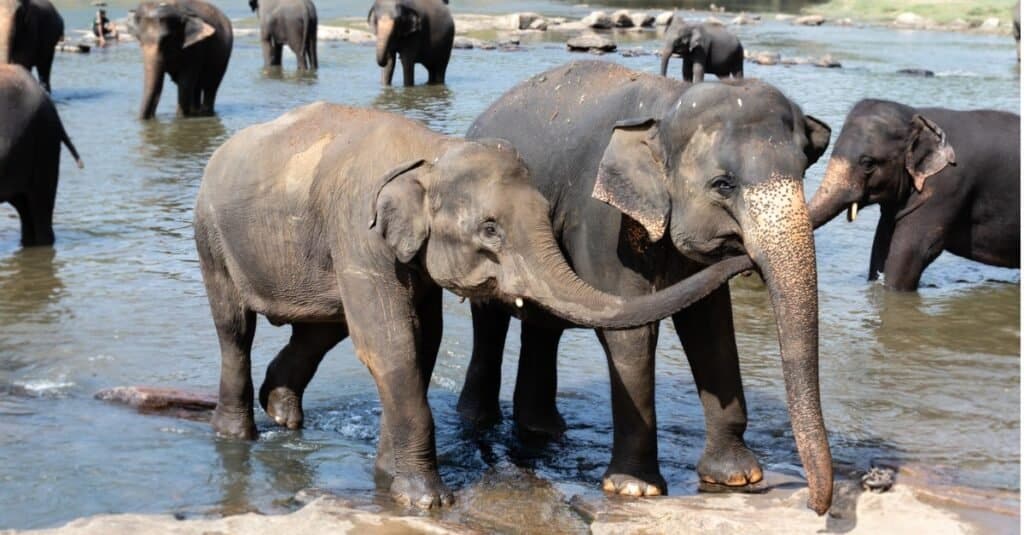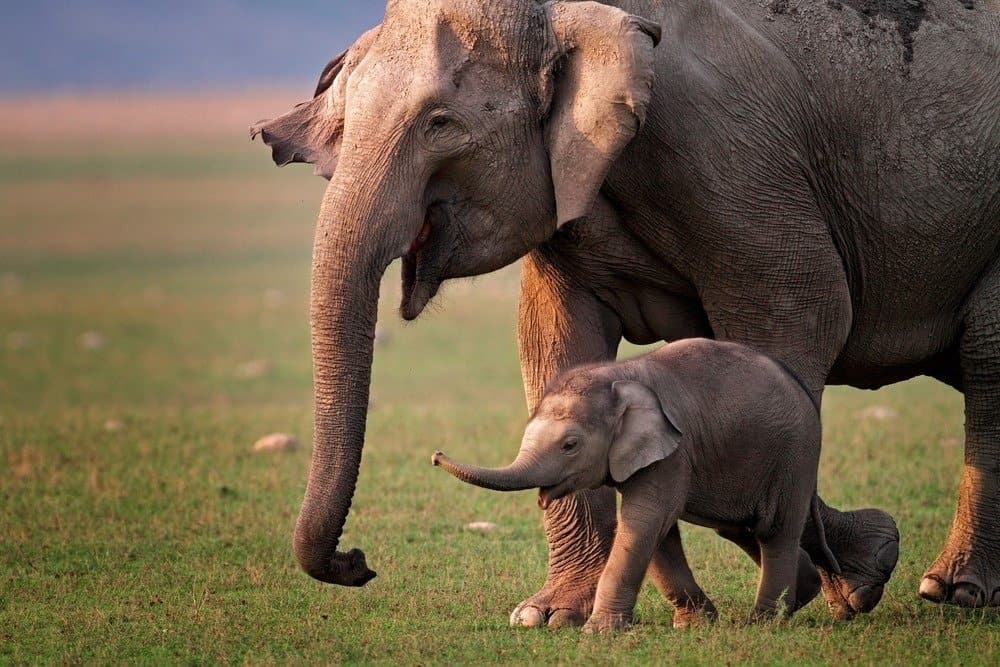
The post An Elephant Being Used In a Festival Finally Decides Enough Is Enough appeared first on A-Z Animals.
In India, elephants are not just animals; they are iconic figures, deeply intertwined with the nation’s spiritual heritage and rich history. Their presence at cultural festivals and temple ceremonies is truly captivating. However, this spectacle comes at a profound and heartbreaking cost to the elephants themselves. As seen in this YouTube video, the stress and cumulative burden of these experiences can eventually push elephants to a dramatic breaking point.
The Enduring Legacy of Elephants in India

Elephants have been used in India for the past 4,000 years.
©Maximillian cabinet/Shutterstock.com
Elephants have been an integral part of Indian culture and history for thousands of years as laborers, soldiers, and religious symbols. Historically, elephants were often employed as work animals, moving heavy loads like logs and other goods, and transporting people. In warfare, almost every Indian dynasty used elephants alongside their foot soldiers and cavalry. Their enormous size and imposing presence intimidated enemies and showcased the kingdom’s wealth and strength. In modern times, elephants continue to be used as religious symbols and in tourism, though their use in logging has declined.
In Hinduism, elephants hold a sacred place as the living embodiment of Lord Ganesha, an elephant-headed god. They symbolize royalty, divinity, peace, good fortune, and power. It’s common to see elephants at temples and participating in religious ceremonies, celebrations, and festivals across India.
An Elephant’s Role in Temples and Festivals

Although their skin is thick, elephants are surprisingly sensitive.
©RobinsonThomas/Shutterstock.com
Elephants frequently participate in religious ceremonies and cultural festivals in India, and are often leased to temples for these events. In religious ceremonies, elephants are adorned with elaborate decorations, including bells, vibrant paint, gold, and flower garlands. Three or four people, along with a deity’s idol, sit atop the elephant as it parades around the temple. Accompanied by loud trumpets, music, colorful dancers, and often firecrackers, the elephant circles the temple three or four times.
Similarly, during cultural festivals, elephants are decorated with dramatic flowers and ornaments. They must calmly navigate crowded streets, often packed with hundreds or even thousands of people, while parading amidst loud music and the celebratory commotion.
The Physical Toll on Captive Elephants

One of the most important things an elephant needs to thrive is its herd.
©iStock.com/Nilanka Sampath
Elephants used in ceremonies and festivals in India endure immense stress on a daily basis. Imagine trying to calmly walk through bustling streets filled with hundreds or thousands of people, all while balancing elaborate decorations and being constantly jostled and shouted at. Elephants are intelligent and incredibly sensitive creatures with heightened senses, feeling every touch and hearing every sound distinctly. This takes a severe toll on them every time they must perform.
However, the stress extends beyond these performances. Elephants are separated from their close-knit families and confined to small enclosures. The elephants lose their emotional companions, families, and access to vast open spaces.
In addition, these elephants undergo strict “schooling” or training. They are taught to bear the weight of people and costumes, and to walk gently through crowds. If they disobey their handlers, they are often punished and sometimes even beaten into submission.
The Dark Side of Traditional Training

An ankus or bullhook is a sharply tipped, metal tool.
©Quality Stock Arts/Shutterstock.com
Historically, captured elephants in India were placed in a “kraal,” or wooden cage. They received food and water for good behavior but were punished for aggression. During training, elephants were forced into a lying position, and if uncooperative, they were hit until they complied.
Forceful submission is a common training method, often involving severe punishment to control the elephant’s behavior. Another technique involves depriving elephants of food and water during their initial days in captivity, feeding them only once they obey commands.
Even today, some trainers continue to use an ankus, or bullhook. This tool is used to apply pressure to sensitive areas to control the elephant’s behavior, and it has been associated with injuries and scarring in some cases.
It is crucial to remember that elephants are not domesticated animals. While they can be trained, they always retain some of their wild instincts. Eventually, these wild tendencies can resurface, especially if an elephant is pushed beyond its limits.
The Emotional Trauma of Captivity

Elephant calves nurse for four to six years and often stay with their mothers for up to 16 years.
©Mogens Trolle/Shutterstock.com
The unnatural and often cruel conditions endured by captive elephants in India inflict severe mental and emotional distress. To force submission, young elephants are torn from their mothers, restrained, starved, beaten, and isolated. This trauma leaves lifelong scars, often causing symptoms and behaviors consistent with PTSD. The prevalent use of fear-based training methods also condemns these intelligent animals to a life of perpetual anxiety, as they constantly anticipate punishment.
In the wild, elephants live in complex, tightly-knit matriarchal herds, forming strong familial bonds among mothers, calves, and grandmothers. However, when captured and kept alone in captivity, they are deprived of these vital social interactions and relationships, which are essential for their overall health and well-being.
Sometimes elephants are chained for extended periods, severely limiting their movement and denying them mental stimulation. As highly intelligent animals, a lack of engagement leads to immense boredom and frustration. Moreover, they are forced to perform for long hours and carry heavy loads amidst overwhelming noise, bright lights, and chaotic crowds. This chronic stress pushes elephants beyond their natural thresholds and greatly weakens their immune systems. This makes them more susceptible to illness and infection and can also lead to apathy and depression.
The Dangerous Consequences of Chronic Stress

Elephants are one of the most empathetic and intelligent animals on Earth.
©YouTube/sivaprasad94 – Original
While elephants are often gentle, they are also enormous, sensitive, and fundamentally wild animals. An elephant may attack a human if it feels threatened, scared, or overwhelmingly stressed. Defensive reactions can be triggered if they are startled or if humans invade their personal space. Sudden movements and loud noises are particularly problematic, given their highly sensitive senses. Elephants also have long memories, and past abuse or harassment can trigger a dangerous response in the present.
The immense stress, fear, and inhumane conditions these elephants endure cause severe distress and frustration, leading many captive elephants to eventually “snap” or “lash out.” At some point, much like the elephant in the YouTube video, they reach their breaking point. This is extremely dangerous for both elephants and festival attendees. In 2024 and 2025, there have been multiple incidents at festivals in India, particularly in Kerala, where captive elephants have caused injuries and deaths, including several fatal attacks during temple festivals.
The post An Elephant Being Used In a Festival Finally Decides Enough Is Enough appeared first on A-Z Animals.
June 06, 2025 at 05:32PMKellianne Matthews
.jpeg)
.jpeg)

0 Comments